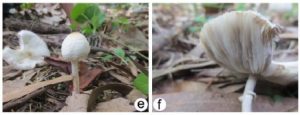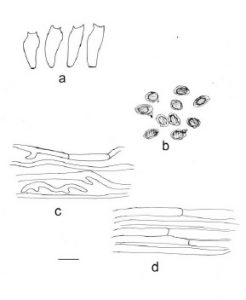Chlorophyllum hortense (Murrill) Vellinga, Mycotaxon 83: 416 (2002) Index Fungorum number: IF 374396
Synonymy: Lepiota hortensis Murrill, N. Amer. Fl. (New York) 10(1): 59 (1917)
:Leucoagaricus hortensis (Murrill) Pegler, Kew Bull., Addit. Ser. 9: 414 (1983)
Pileus 6.5 cm wide, oval or nearly round when young, becoming convex to plane on maturity, centre tinged yellow brown, yellowish brown squamules on white background, red on bruising, striated margins. Gills white to greyish, broad, unequal and free. Stipe 4.5 to 6.0 cm long and up to 0.7 cm wide, white from upper portion and brown from the base, equal, central. Annulus present, white, movable in age, persistent.
Basidia 17.6–24.0 × 7.2–9.6 μm, clavate, hyaline. Basidiospores 6.4–8.0 × 4.8–5.6 μm, avL=7.2, avW=5.2, Q=1.3–1.4, ellipsoid, apiculate, germ pore absent, monoguttulated, olive green to light blue, dextrinoid, smooth. Pileus and stipe context hyphae 4.0 to 12.0 μm and 8.0 to 18.0 μm wide respectively, hyaline, septate.
Material examined: India, Jammu & Kashmir, Jammu, University Campus, from litter,humicolous, 4 Aug 2015, Roshi Sharma & Y.P. Sharma, HBJU 408.
Distribution : Reported from China and Brazil.
Notes: A new record for India. This species has been reported by Ge & Yang 2006, Nascimento & Alves 2014. Most of the features of the above described specimen are in line with the description given by Vellinga (2003) except for spore size which is smaller in our case. The species can be easily identified by its medium sized basidiocarp, white squamules on the surface of pileus along with yellowish apex and a strong reddening of stipe on bruising.
FIGURE. e Young basidiocarp of Chlorophyllum hortense in natural habitat. f Mature basidiocarp of C. hortense showing lamellae and annulus.

FIGURE. Chlorophyllum hortense a) basidia b) basidiospores c) pileus context hyphae d) stipe context hyphae. Scale bars: a–d = 10 μm.

